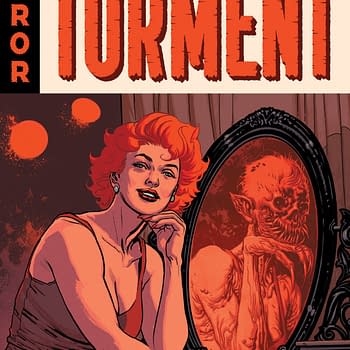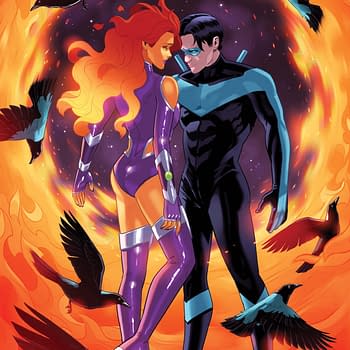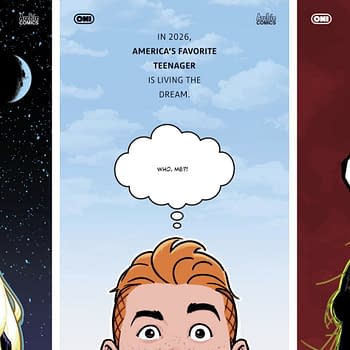Posted in: Comics, Recent Updates | Tagged: 4th Hanzo, Beach Girls, Big Planet Comics, Box Brown, Clockwork Game, Clockwork Games, comixology, ComiXology Submit, Jane Irwin, Miguel Hernandez, Retrofit Comics
Spotlight on ComiXology Submit – Beach Girls, Clockwork Game, 4th Hanzo
Every week, there is quite a selection of new comics available that have been added to ComiXology via their creator-owned Submit platform, and here at Bleeding Cool we're taking a moment to point out some of the titles that have caught our attention this time around that you might find as wacky or as intriguing as we did. This week it's all about personal obsessions and how that pays off for comics creators–you can feel the commitment behind these comics as the stories they feel that they must tell. And that makes them winners.
Top Pick:
Beach Girls, written and illustrated by Box Brown
The indie favorite imprint Retrofit Comics founded by Box Brown teased that in 2014 they'd be making their comics available digitally after their partnership with Big Planet Comics, and here we have Box Brown's Beach Girls in digital glory. Though much of Retrofit's aim is to get print copies into comic shops to build on the massive demand they encounter at indie shows, the move to digital alternatives is an excellent thing to diversify platforms for some of the greats working independently right now. Beach Girls has an initial tone of beguiling simplicity, but the arc of the story is as compelling as a Bergman film and you find yourself reading it more and more quickly to find out what will happen to the central characters, including a wannabe "beach girl" with her friends on vacation vowing to try surfing and marijuana, and hopefully find "romance". She encounters her counterpart in somewhat cynical surfer Hank who watches the "seasonal" people come and go but manages to pass on more of his wisdom and angst than he intended this time around.
The snapshots of life, from a skate shop on the boardwalk, to the endless cycle of burritos, to the deeper allure of the ocean and its mysteries, create a collage-like impression of the surface details of summer life with its shallower aspects and the underlying, darker questions Hank faces in his own semi-berserker way. Brown's artwork has a massive cult following, and here we see his classic ability to use distance shots, limited dialogue, and significant statements with a light touch. It's an existential soap opera that also celebrates the ephemeral aspects of life, and for me, at least, reaffirms that you can find meaning in everything no matter how much of a pastime life may seem at times. Beach Girls stays with you and keeps you thinking and commemorates those larger than life figures who tackle existence on their own terms.
You might also like:
Clockwork Game, written and illustrated by Jane Irwin
I first heard about this historically-set graphic novel from a friend of mine who was oozing enthusiasm for the delightfully creative Kickstarter that launched the book, offering finely bound artist editions of the book that made it a collector's item from the start. Set in the 1840's but jumping around in times previous, the story centers around a famous automaton, a chess-playing clockwork man, and the origins and development of automatons that brings us up to 19th century Philadelphia. As a subject matter, its highly individual and offers readers a new world to explore. In digital format, this book has "interactive links" between the notes and the texts and references historical documents, all creating an enriched storytelling universe. There's an etching-like feel to Irwin's inking, and her commitment to historical architecture is appealing while keeping a storybook feel to her rendering of characters. The artwork is highly detailed, never using shorthand where accuracy will do the extra lifting. The story moves around in time at relevant junctures to trace the history of our chess-playing automaton and discover how he ended up in Philadelphia drawing the attention of an engineer and enthusiast. Automatons do preserve a haunted feel, even when you know their inner workings, and Irwin seems to capture both aspects of their nature–their scientific sophistication (in this case he's able to play a "unique" game of chess every time) and their mysteries.
It's amazing how the first panel where the automaton comes to "life" gives the impression, quite firmly, that you're meeting a central character for the first time. He looks outward at the reader, moves, and operates, and it's hard to distinguish him from a human being. Comics are particularly well suited to tell this story because they create their own "ghost in the machine" to bring the automaton to life and make us question illusion and reality. Clockwork Game is a fascinating book brought to fruition by a very committed writer and artist (publication info suggests the book evolved over a 5 year period), and we reap the benefits as readers in a new gem to discover.
4th Hanzo, written and illustrated by Miguel C. Hernandez
In 4th Hanzo, we enter into a world with certain genre expectations–this is a ninja history featuring animals, and the written prologue immediately made me laugh because it is so similar to the necessary narrative overlay at the beginning of any samurai/ninja film, whether its part of a series or not. Hernandez handles the narrative traditions behind the book with a certain respect and attention to detail that impresses me. Heavy zen-like ponderings about life and the motivations behind our actions (in this case Hanzo is returning from training in the forest and considering why he is returning to his family home) are counterbalanced with much lighter, more conversational dialogue to create an interesting counter point rhythm. Watch out for a Spider-Man quote or two couched in ruminations. Hanzo, last of his family and set to rule, has plenty to untangle as his clan faces oppressive foes, and he's feeling responsible for the younger generation, who view "unkie Hanzo" as something of a legend. Points to Hernandez for deciding to keep relative animal size equal to the natural world so that when ninja Hanzo takes on a Racoon, he's taking on a goliath, and the differences between species ads an extra layer of complication to combat scenes. Little details eventually make it clear that this is a world where humans live, too, and that these animal dramas are playing out on a small scale while a bigger universe revolves around them. This ads to the humor in the story, but doesn't take away from the internal logic of the struggle for protection and power in Hanzo's village. It's not only an entertaining book, it's a successful mash up of elements that will appeal to a variety of tastes in comics.


















